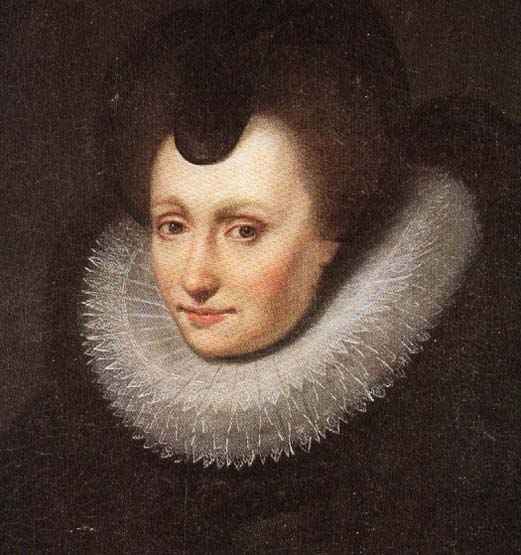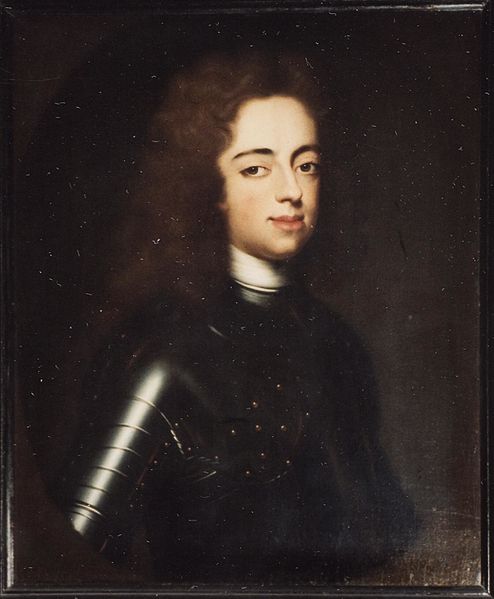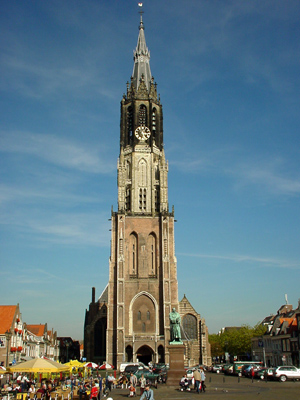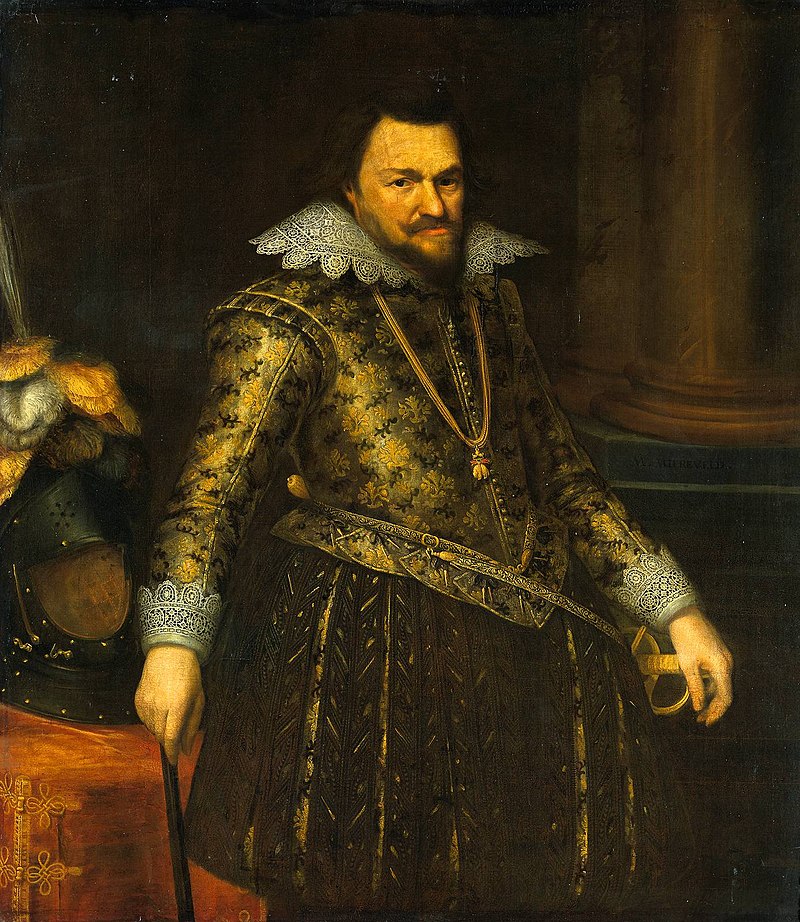by Susan Flantzer © Unofficial Royalty 2018

Willem I (the Silent), Prince of Orange; Credit – Wikipedia
In the Netherlands, Willem I (the Silent), Prince of Orange is known as the Vader des Vaderlands (Father of the Fatherland), and the Dutch national anthem, the Wilhelmus, was written in his honor. He got his nickname “the Silent” (in Dutch De Zwijger) not because he was quiet, but because of his habit of holding his tongue in difficult situations. Willem is the founder of the House of Orange-Nassau and the ancestor of the Dutch monarchs, the British monarchs from King George I forward, and other European royal families. Willem was the eldest of the twelve children of Willem, Count of Nassau-Dillenburg and his second wife Juliana of Stolberg-Werningerode. He was born on April 24, 1533, at Dillenburg Castle, then in the County of Nassau-Dillenburg in the Holy Roman Empire, now in Hesse, Germany.
Willem had two half-sisters from his father’s first marriage to Countess Walburga of Egmont:
- Elisabeth (1520 – 1523), died in early childhood
- Magdalene (1522 – 1567), married Count Herman of Neuenahr and Moers
Willem had eleven younger siblings:
- Hermanna (born and died 1534), died young
- Count Jan VI of Nassau-Dillenburg (1536 – 1606), married (1) Elisabeth of Leuchtenberg, had 13 children (2) Kunigunde Jakobäa of Simmern, had four children (3) Johannetta of Sayn-Wittgenstein, had 7 children
- Lodewijk (1538 – 1574), unmarried
- Maria (1539 – 1599), married Count Willem IV van den Bergh, had 16 children
- Adolf (1540 – 1568), unmarried
- Anna (1541 – 1616), married Count Albert of Nassau-Weilburg, had 14 children
- Elisabeth (1542 – 1603), married Count Conrad of Solms-Braunfels, had 14 children
- Catharina (1543 – 1624), married Count Günther XLI of Schwarzburg-Arnstadt, no children
- Juliana (1546 – 1588), married Count Albrecht VII of Schwarzburg-Rudolstadt, had 10 children
- Magdalena (1547 – 1633), married Count Wolfgang of Hohenlohe-Weikersheim, had 15 children
- Hendrik (1550 – 1574), unmarried
Until Willem was eleven years old, he received a Lutheran education at home. His mother was a determined Lutheran and passed her strong Protestant convictions to her children. When Willem’s childless cousin René of Châlon, Prince of Orange died in 1544, he left the Principality of Orange to Willem. The Principality of Orange was a feudal state in Provence, in the south of modern-day France. Today, the title Prince/Princess of Orange is held by the heir apparent of the Dutch monarch.
Willem also received land in present-day Germany, Belgium, and the Netherlands. However, Charles V, Lord of the Netherlands and Holy Roman Emperor attached the condition that eleven-year-old Willem would convert to Roman Catholicism and receive a Roman Catholic education. Because of the immense inheritance, Willem would receive, his parents agreed. In the court of Emperor Charles V, German-speaking Willem learned Latin, French, Spanish, Italian, and Dutch and received a military and diplomatic education.
Willem married four times.

Anna van Egmont; Credit – Wikipedia
(1) On July 8, 1551, 18-year-old Willem married his first wife Anna van Egmont, a wealthy Dutch heiress, the only child of Maximiliaan van Egmont and Françoise de Lannoy. Because Anna’s father had died, Willem acquired his titles, Lord of Egmond and Count of Buren, on his wedding day. Anna’s early death at the age of 25, on March 24, 1558, brought much grief to Willem.
Willem and Anna had three children:

Anna of Saxony; Credit – Wikipedia
(2) On August 25, 1561, William married his second wife, Anna of Saxony, the only surviving child and heiress of Maurice, Elector of Saxony and his wife Agnes of Hesse. Anna’s dowry of 100,000 thalers was a very large amount of money. The marriage was an unhappy one.
Willem and Anna had five children but only three survived to adulthood:
In early 1571, Anna realized she was pregnant. Immediately, the paternity was controversial. Two possibilities were discussed: either Anna’s husband Willem, who had visited Anna and his children during Christmas 1570, was the father or the lawyer Jan Rubens, the future father of the painter Peter Paul Rubens, who spent a lot of time with Anna as her legal adviser was the father. A daughter, Christine, was born in August 1571.
Willem knew that his non-recognition of the child as his daughter would be a pretext for divorce by accusing Anna of adultery. Wilhelm accused Rubens of having had an adulterous relationship with his wife and of being the biological father of Christine. Rubens was imprisoned and threatened with execution. He confessed to adultery under torture and was pardoned on the intercession of his wife. Anna also admitted the adultery, but she denied that Rubens was the father. On December 14, 1571, Anna was forced to agree to a divorce. Christine, who had been given Diez as a surname, was not recognized by Willem as his child and he did not have to pay any further maintenance for her. In 1572, Anna was sent to her family in Saxony where they imprisoned her as an adulteress until she died in 1577.

Charlotte de Bourbon-Monpensier: Credit – Wikipedia
(3) On April 24, 1575, Willem married his third wife Charlotte de Bourbon-Monpensier, daughter of Louis, Duke of Montpensier and Jacqueline de Longwy, Countess of Bar-sur-Seine. She was a former French nun who converted to Calvinism and escaped the convent. This marriage was Willem’s happiest marriage. Charlotte died from pneumonia on May 5, 1582, at the age of 35. Willem was recovering from an assassination attempt and his doctors feared his grief might cause a fatal relapse.
Willem and Charlotte had six daughters:
- Louise Juliana (1576 – 1644), married Friedrich IV, Elector Palatine, had eight children including Friedrich V, Elector Palatine, grandfather of King George I of Great Britain
- Elisabeth (1577 – 1642), married Henri de La Tour d’Auvergne, had seven children
- Catharina Belgica (1578 – 1648), married Count Philipp Ludwig II of Hanau-Münzenberg, had ten children
- Charlotte Flandrina (1579 – 1640), converted to Roman Catholicism and became a nun
- Charlotte Brabantina (1580 – 1631), married Claude, Duc de Thouars, had four children
- Emilia Antwerpiana (1581 – 1657), married Friedrich Casimir, Count Palatine of Zweibrücken-Landsberg, had three children

Louise de Coligny; Credit – Wikipedia
(4) On April 12, 1583, Willem married his fourth wife, French Huguenot Louise de Coligny, daughter of Gaspard II de Coligny and Charlotte de Laval. Her father was a French nobleman and admiral but is best remembered as a leader of the Huguenots (French Calvinist Protestants). Louise had previously been married to Charles de Teligny. Both he and Louise’s father were killed during the St. Bartholomew’s Day Massacre in 1572 when thousands of Huguenots were murdered. Louise survived Willem.
Willem and Louise had one son:

Willem in 1555; Credit – Wikipedia
As a young man, Willem served at the court of Charles V, Holy Roman Emperor in Brussels and became a confidant of Charles. Physically exhausted after 40 years of ruling, Charles abdicated in 1555 and retired to the peace of a monastery, where he died three years later. Upon Charles’s abdications, his younger brother Ferdinand, who had already been given the Austrian lands in 1521, was elected Holy Roman Emperor. Charles’s son was now King Philip II of Spain having inherited the Spanish Empire, including the possessions in the Netherlands and Italy.
In 1559, Philip appointed Willem Stadtholder (governor) of the provinces of Holland, Zeeland, and Utrecht (all in the present-day Netherlands) greatly increasing his political power. Willem soon became one of the most prominent opposition members in the Council of State who were seeking more political power for themselves and also for the Dutch nobility because too many Catholic Spaniards were involved in governing the Netherlands. King Philip II was a devout Roman Catholic and envisioned an empire with Roman Catholicism as the only religion. Willem had been brought up as a Lutheran but had converted to Roman Catholicism. However, he was a strong proponent of freedom of religion and was increasingly disturbed by the persecution of Protestants by the Catholic Spaniards in the Netherlands. In addition, Willem wanted to see the end of Spanish troops in the Netherlands.
In 1568 the Netherlands, led by Willem, revolted against Philip II because of high taxes, persecution of Protestants, and Philip’s efforts to modernize and centralize the medieval government structures of the provinces. This disagreement eventually resulted in the Eighty Years War which resulted in the independence of the northern United Provinces in 1581. The United Provinces, also known as the Dutch Republic, a confederation of seven provinces, that had their own governments and were very independent. The States-General consisted of representatives of each of the seven provinces: Duchy of Guelders, County of Holland, County of Zeeland, Lordship of Utrecht, Lordship of Overijssel, Lordship of Frisia, and Lordship of Groningen and Ommelanden. The Princes of Orange, beginning with William the Silent, were always chosen as stadtholders (governors) of most of the provinces.
In 1573, Willem left the Roman Catholic Church and became a member of the Dutch Reformed Church, a Calvinist reformed religion that followed the practices of John Calvin. He was declared an outlaw in 1580 by Philip II, who called Willem “a pest on the whole of Christianity and the enemy of the human race.” Philip offered 25,000 crowns to anyone who killed Willem. Willem responded with a document, Apology, which defended his actions, attacked Philip II, and restated his allegiance to the Protestant reform religion. On March 18, 1582, Juan de Jáuregui, a Spaniard, attempted to assassinate Willem. He was severely wounded but survived due to the care of his third wife Charlotte and his sister Maria. Unfortunately, while William slowly recovered, Charlotte became exhausted from providing intensive care and died.
In 1584, Balthasar Gérard, a subject and supporter of Philip II who regarded Willem as a traitor to both Philip and the Catholic religion, succeeded in assassinating Willem. On July 10, 1584, Willem had lunch with his sister, his wife, his daughter, and Rombertus van Uylenburgh, Mayor of Leeuwarden at the Prinsenhof in Delft. After lunch, Willem began to climb the stairs to his second-floor chamber where he worked and slept. Gérard, who had been hiding behind a pillar, jumped out and fired two shots at the 51-year-old Willem, who collapsed and died. The killer was arrested after a wild pursuit and was brutally tortured and then executed on July 14, 1584. Instead of giving Gérard’s parents the reward of 25,000 crowns, Philip II instead gave them three country estates and a peerage.

Site of the assassination, bullet holes are still in the wall; Credit – Door Looi uit nl, https://commons.wikimedia.org/w/index.php?curid=2287221
Willem had been planned to be buried at the Grote Kerk in Breda, where the House of Orange was traditionally buried, but Breda was under Spanish control. Instead, Willem was buried in the Old Crypt at the Nieuwe Kerk ( New Church) in Delft, South Holland (Zuid-Holland), the Netherlands. His memorial was originally very modest but was replaced in 1623 by a new one, made by Hendrik de Keyser and his son Pieter. Since then, most of the members of the House of Orange-Nassau, including all Dutch monarchs, have been buried in the same church in the royal vault whose entrance, sealed by a large stone cover with four brass rings, is behind the tomb of Willem the Silent. Willem’s fourth wife Louise de Coligny was buried with him.

The Old Crypt with the body-like lead sarcophagus of Louise de Coligny on the bottom right and Willem I, Prince of Orange’s coffin on the bottom left; Credit – Wikipedia

Memorial to Willem the Silent; Credit – By Alexander Williams – Own work, CC BY-SA 4.0, https://commons.wikimedia.org/w/index.php?curid=80947669
This article is the intellectual property of Unofficial Royalty and is NOT TO BE COPIED, EDITED, OR POSTED IN ANY FORM ON ANOTHER WEBSITE under any circumstances. It is permissible to use a link that directs to Unofficial Royalty.















































 As the bride and groom made their procession from the Palace of Justice, guests had already arrived and were seated in the Grote of Sint-Jacobskerk. The several hundred guests included members of the Dutch Senate and the Chamber of Deputies, members of the Diplomatic Corps, representatives of nearly every town and city in the Netherlands, members of the court, and other personal friends. The procession into the church began with the foreign royal guests and family members, with the bride and groom the last to arrive. Despite the glitter of jewels and the numerous prominent guests, the service was the very simple and traditional marriage service of the Dutch Reformed Church, described as a service of “puritanical simplicity”, with no bridesmaids or groomsmen. The couple exchanged their vows and rings, followed by an address by the Chaplain. Following a final blessing, they made their way out of the church, to process back to Noordeinde Palace.
As the bride and groom made their procession from the Palace of Justice, guests had already arrived and were seated in the Grote of Sint-Jacobskerk. The several hundred guests included members of the Dutch Senate and the Chamber of Deputies, members of the Diplomatic Corps, representatives of nearly every town and city in the Netherlands, members of the court, and other personal friends. The procession into the church began with the foreign royal guests and family members, with the bride and groom the last to arrive. Despite the glitter of jewels and the numerous prominent guests, the service was the very simple and traditional marriage service of the Dutch Reformed Church, described as a service of “puritanical simplicity”, with no bridesmaids or groomsmen. The couple exchanged their vows and rings, followed by an address by the Chaplain. Following a final blessing, they made their way out of the church, to process back to Noordeinde Palace.





